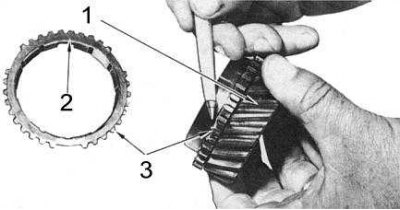Transmission and transfer box
Having difficulty shifting gears
Clutch not fully depressed. See the section on clutch troubleshooting.
The gearbox has the wrong grade of gear oil. Change oil to specification (see tables of sizes and adjustments at the end of the guide).
Worn gearshift mechanism. On 4.2L models, remove the top cover and replace defective components. On 3.0L models, disassemble the transmission assembly for repair.
Faulty synchronization mechanism. Overhaul the transmission. Check the condition of the friction surfaces of the blocking rings and cones for signs of wear and damage (see accompanying illustration).

1 - synchronizer cone
2 - blocking ring
Transmission makes clang when downshifting
Clutch not fully depressed. See the section on clutch troubleshooting.
The wrong grade of gear oil was filled into the gearbox. Change oil (see tables of sizes and adjustments at the end of the guide).
Faulty synchronization mechanism. Overhaul the transmission. Check timing teeth on gears and lock rings for chips and signs of wear (see accompanying illustration).

1 - 2nd gear gear
2 - blocking ring
3 - synchronizing teeth
Excessive axial play of the gears of the driven shaft and / or the intermediate shaft of the transmission. Disassemble the transmission assembly and replace the defective components.
Going on "jumping off" transmission from selected gear
Excessive play in gear lever. Disassemble the lever-case assembly and replace worn components.
Worn gearshift mechanism. On 4.2L models, remove the top cover and replace defective components. On 3.0L models, disassemble the transmission assembly for repair.
Faulty synchronization mechanism. Overhaul the transmission.
Excessive axial play of the gears of the driven shaft and / or the intermediate shaft of the transmission. Disassemble the transmission assembly and replace the defective components.
The bearings of the primary or driven shafts of the gearbox are worn out. Disassemble the transmission assembly and replace the bearings.
Note. In most cases, this situation is caused by wear or damage to internal transmission components.
Transmission makes unusual noises in neutral
The transmission oil level has dropped. Check transmission for signs of leaks. Make the necessary corrections, add the required amount of oil of the required grade.
Gearbox input shaft bearings worn. Disassemble the transmission and replace the bearings.

Note. If bearings are fitted with a cage and cannot be visually inspected, wash them thoroughly in solvent, lightly lubricate and rotate slowly by hand, checking for jerks and bite points (see accompanying illustration).
The intermediate shaft gears of the transmission have defects in the form of chips or cavities, or the shaft bearings are worn out. Overhaul the transmission by replacing damaged components.
Excessive axial play of the intermediate shaft of the transmission. Disassemble the transmission and replace defective components.
Note. To detect transmission noise in neutral, depress the clutch with the engine running and shift into any gear. If the noise disappears, then its source is the transmission.
Transmission or transfer case is noisy (any of the forward gears is engaged, the car is moving)
The transmission oil level has dropped. Check transmission for signs of leaks. Make the necessary corrections, add the required amount of oil of the required grade.

Note. Traces of oil in the base of the parking brake drum indicate a failure of the transfer case oil seal (see accompanying illustration).
Worn transmission or transfer case bearings. Disassemble transmission/transfer case, replace bearings.
Gears have defects in the form of chips and cavities. Overhaul the transmission/transfer case by replacing damaged components.
Excessive axial play of the intermediate shaft of the transmission or transfer case. Disassemble transmission/transfer case, replace defective components.
Difficulty switching transfer case modes
Transfer case switch components worn or loose. Tighten fasteners or replace defective components.
Worn hub splines and upshift/downshift clutches. Overhaul the transfer case.
Damaged or worn splines on the up/down hub or input (primary) shaft. Overhaul the transfer case.
Difficulty turning on all-wheel drive mode
Transfer case switch components worn or loose. Tighten fasteners or replace defective components.
Worn 4WD synchronizer components. Overhaul the transfer case.
Worn or damaged 4WD synchromesh sprocket teeth.
Note. Difficulties in turning on the all-wheel drive mode may also be associated with the difference in the size of the tires of the front and rear wheels of the car. Make sure you select the right wheels.
If shifting to 4WD is only a problem when cold, slow down to a complete stop.
Cardan shafts
There is vibration in the propeller shaft
Loose nuts and/or bolts securing propeller shaft. Replace the fastener by tightening it to the required torque.
Worn cardan joints. Check and replace if necessary.
Driveshaft bent. Check the shaft runout with a plunger-type dial gauge, compare the measurement with the allowable values (see tables of sizes and adjustments at the end of the guide).
The propeller shaft is out of balance. Check for balance weights on the shaft. If necessary, balance the shaft.
There was a mutual misalignment of the front and rear universal joints of the shaft. Disconnect the sliding joint from the shaft and align the joints.
The splines of the propeller shaft sliding joint are worn out. Replace shaft assembly.

Note. Using manual manipulation, check the universal joints and sliding joints for signs of wear (see accompanying illustration).
If there is excessive runout of the cardan shaft, give the fasteners and turn the shaft half a turn. Retighten fasteners and recheck runout. Replace the shaft if necessary.
There is excessive radial play in the cardan shaft

Loose propeller shaft bolt/nuts. Replace the fastener by tightening it to the required torque. Make sure the fasteners are securely tightened (see accompanying illustration).
Worn cardan joints. Check the degree of wear of the hinges by manipulating them manually. Replace if necessary.
The splines of the propeller shaft sliding joint are worn out. Check (by manual manipulation), if necessary, replace the shaft assembly.
Excessive radial play of the crown (slave) main gear gears. Remove the final drive assembly, adjust the driven gear.